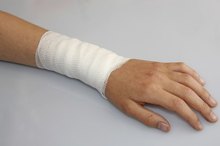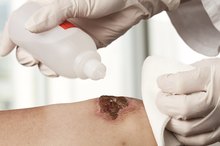How to Treat a Rug Burn
A rug burn is a form of first degree burn caused by friction. With a rug burn, the friction that is generated from the contact between the skin and the rug generates a mild amount of heat. This heat causes damage to the tissue in the top layer of skin. Rug burns and other types of first degree burns rarely cause any serious medical problems, but they can be quite painful 1. There are a variety of ways to treat a rug burn.
Remove clothing or jewelry from the burned part of the body. This is an important part of treating first degree burns, Pennsylvania State's Medical Center explains, because it makes it easier to get access to the burned tissue and also prevents any other materials to contact the burn, which can make the pain worse 1.
Home Remedies of a Blister Resulting From a Burn
Learn More
Apply cool water to the burn for five to ten minutes. This can be achieved by running cool or cold water over the burn or by submerging the burned portion of the body in cold water, MedLinePlus states 2. Alternately, a rag or washcloth can be soaked in cold water and applied to the burn. The cool water helps dissipate the heat from the friction, which keeps the burn from getting worse. It is important not to use ice or ice water, as the extreme cold will actually make the burn worse.
Wash the burn with an antiseptic cleanser. This will help prevent bacteria from infecting the damaged tissue.
How to Prevent a Burn From Leaving a Scar
Learn More
Cover the burn with a dry and sterile protective covering, such as a gauze pad. This will help protect the burned area and allow it to heal more easily. It is important to not apply any bandages with adhesive to the burn, Pennsylvania State's Medical Center explains, as this can restrict airflow to the burn, slowing the healing process 1.
Keep the burned area protected from friction and pressure. While the damaged skin is healing, it is more delicate than it would normally be and can easily be damaged by more friction or burning. Whenever possible, patients with rug burns should keep a gauze pad or some other protective covering over the burn to prevent additional injury.
Use ibuprofen, aspirin or acetaminophen to relieve pain. Rug burns can be painful but these over-the-counter medications are generally adequate for the treatment of pain from friction burns, MedLinePlus explains 2.
Check the burned area at least once each day for signs of worsening redness or infection. One of the greatest risks of a first degree burn is that bacteria can infiltrate the damaged skin, leading to a painful and potentially dangerous infection. Signs of an infection include worsening pain, expanding areas of swelling or redness and the appearance of pus or other liquid seeping from the burn.
Warnings
Do not give aspirin to children under the age of 12, as this can lead to a dangerous condition known as Reye Syndrome.
Related Articles
References
- Pennsylvania State Medical Center: First Degree Burns
- MedlinePlus: Burns
- Davidson CC, Eadie PA. Burning more than calories: treadmill friction injuries in children. Irish Medical Journal. 2009;102(10):320-3. doi:10.1007/s11552-007-9046-2
- Jeremijenko L, Mott J, Wallis B, Kimble R. Paediatric treadmill friction injuries. Journal Of Paediatrics And Child Health, 2009;45(5), 310-312. doi:10.1111/j.1440-1754.2008.01329.x
- Klotz T, Kurmis R, Munn Z, Heath K, Greenwood J. Moisturisers in scar management following burn: A survey report. Burns. 2017;43(5), 965-972. doi:10.1016/j.burns.2017.01.021.
- Menon S, Ward D, Harvey J, Hei E, Holland A. Friction burns in children. Journal Of Burn Care & Research. 2012;33(6), 736-740. doi:10.1097/bcr.0b013e3182504469
- Ortiz-Prado E, Armijos L, Iturralde, A. A population-based study of the epidemiology of acute adult burns in Ecuador from 2005 to 2014. Burns. 2015;41(3), 582-589. doi:10.1016/j.burns.2014.08.012.
Writer Bio
Adam Cloe has been published in various scientific journals, including the "Journal of Biochemistry." He is currently a pathology resident at the University of Chicago. Cloe holds a Bachelor of Arts in biochemistry from Boston University, a M.D. from the University of Chicago and a Ph.D. in pathology from the University of Chicago.







